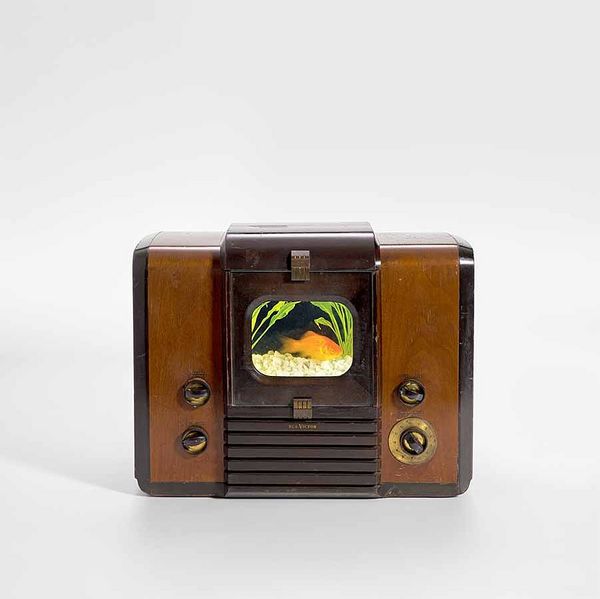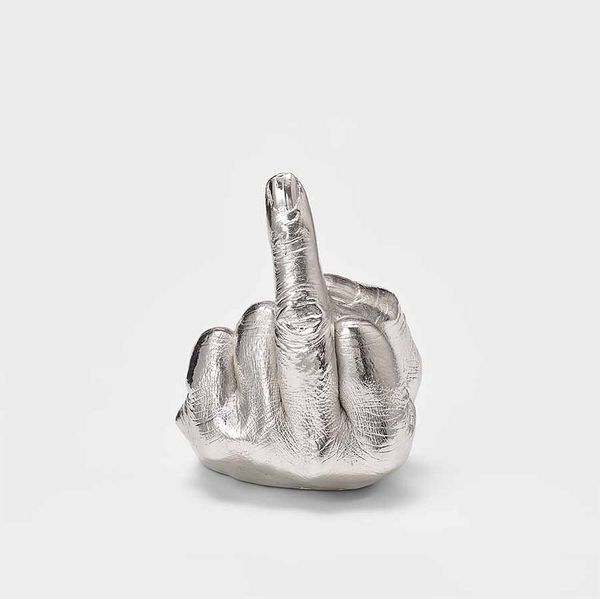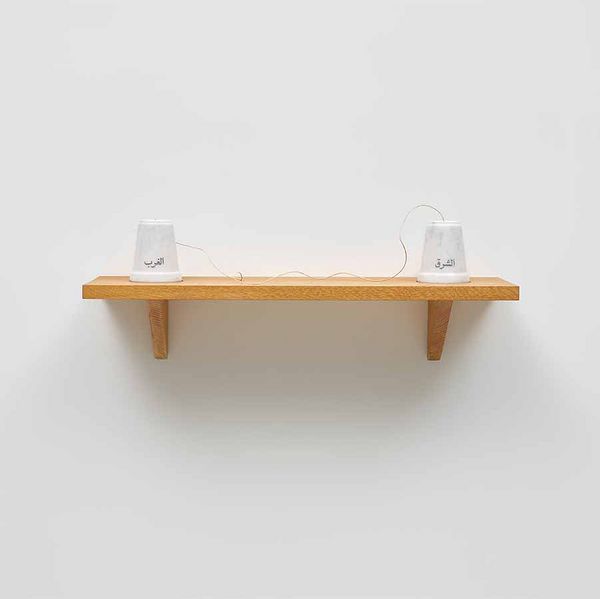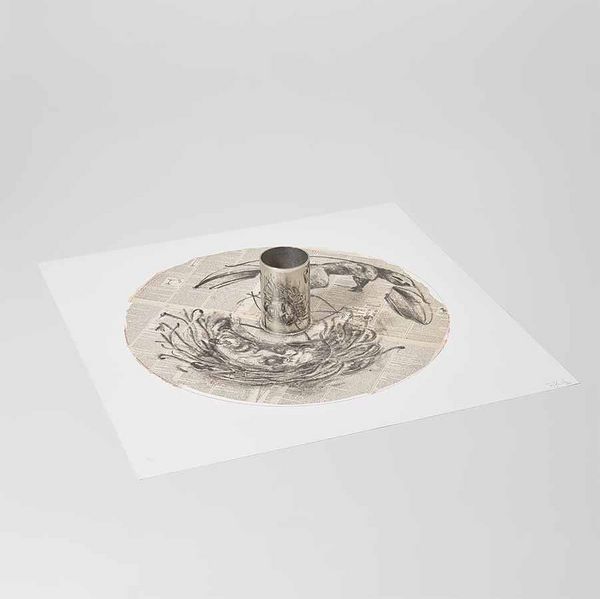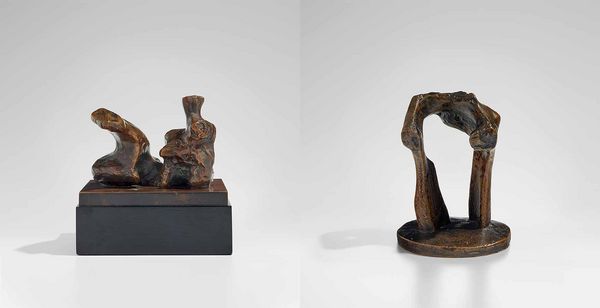Nam June Paik, Sonatine for Goldfish, 1992. Evening & Day Editions London.
Nam June Paik: The unbearable weight of being right about everything
Phones this, phones that. Say what we will about the endless scroll; the fact is the kids have it too easy today. There used to be a time when we had to be present, at a specific time, in a specific room of the house, just to get our propaganda. Now you can do that anywhere – and we still won’t leave the house. Such is the staying power of Nam June Paik’s Sonatine for Goldfish that its immediacy hasn’t lost picture quality since 1992. (Things back then were built to last, you hear from the other room, as though being listened to.) Paik was captivated by television. For him, the TV set was not just a passive medium for displaying information, but an active instrument capable of disseminating narratives and shaping norms on a societal scale. By repurposing the TV and presenting a live goldfish within it, Paik highlighted the intersection of natural and manufactured worlds, building out his idea of a harmonious global ecosystem within which nature and technology coexist, or even thrive. At once a totem of the techno- circumspection which prevailed in the 1990s from Baudrillard to Underworld and The Truman Show, Paik offers a prescient object for the cultural landscape at the end of history. The screen shrinks, the content diminishes with it; its reach widens, consensus reality follows. Goldfish not included, only its memory span.
Ai Weiwei: Petty and profound
Ai Weiwei, Artist's Hand, 2017. Evening & Day Editions London.
At times a gesture takes a while to catch on, at others it hits at just the right moment, like Ai Weiwei’s 2017 Artist’s Hand, the same year the middle finger emoji was released as part of the iOS 9.1 software update. Previously, one had to be a bit more worldly to fire off a good vulgarity in the chat – say, ✌️ in certain countries, 🤟in others, and even 🖐️ in, well, look it up, we can’t sit here and offend all day. Now it’s all generational warfare for various smileys and their ever-changing meanings, but the middle finger is, quite effectively, forever. Considered one of the oldest insulting gestures known to humankind owing to its phallic resemblance, the finger is also a longstanding expression for the artist, whose Study in Perspective began in 1995 and has since gone open source across social media; we’d be hard pressed to think of a single institution or landmark that hasn’t been given the one-finger salute, and Weiwei returns to the motif regularly – this rhodium-plated multiple is from his 2017 Good Fences Make Good Neighbors exhibition charity campaign with the Public Art Fund. Ultimately, a fence and a middle finger stand for the same thing, and Ai Weiwei uses his free hand to wind up the other like a crane erecting a post, wherever in the world he wants to expand its meaning.
Man Ray: It is what it isn't
Man Ray, Proverb, 1973. Evening & Day Editions London.
Here’s a proverb: A broken clock is right twice a day.
Here’s Ezra Pound: Compose in the sequence of the musical phrase, not in sequence of a metronome.
Here’s an inscription from the Luxor Obelisk in Paris: “The Horus of the upper and lower country, the powerful bull, beloved of the Sun, the King of Upper and Lower Egypt, Ra-user-ma, approved of the Sun, lord of the festivals, like Ptah-Tanenen, son of the Sun, Ramesses, beloved of Amen, a strong bull, like the son of Nu (Osiris), whom none can withstand, the lord of the two countries, Ra-user-ma, approved of the Sun, son of the Sun, Ramesses II, beloved of Amen, giver of life, like the Sun.”
And here’s a joke about knitting: A police officer spotted a person knitting while driving. "Pullover!" he yelled. "No, it's a scarf!" they replied.
So what is Man Ray’s Proverb? A religious ornament? A desktop object? Some combination of a timekeeping device and a funereal monument? The artist intentionally left the title’s meaning as vague as its composition – he even referred to the knitting needle as “like a thermometer,” although it doesn’t resemble one – to invite the viewer to reinterpret everyday objects and their associative meanings. This ambiguity is a hallmark of Surrealist art, and moreover a defining characteristic of the readymade, positioning the item anywhere from fun to provocative. The obscure music enthusiasts that make up our editorial department like to think of it as the tuning key, chronometer, and ideal room temperature gauge for performing an imaginary early version of John Cage’s 4’33’’, entitled 0’00’’.
Mona Hatoum: See something, say something
Mona Hatoum, Set in Stone, 2002. Evening & Day Editions London.
British-Palestinian artist Mona Hatoum’s multimedia work delves into themes of containment, displacement, conflict, and home. Through a wide range of mediums – particularly installation, sculpture, performance, and works on paper – the artist’s unique visual language transforms familiar domestic objects into menacing forms while maintaining their uncanny familiarness, as seen in Set in Stone. Between the two cup-like marble forms bearing East and West in Arabic script runs a length of string, a tenuous line between two firm, obstinate poles. It is reminiscent of the childhood game of telephone, made threatening by the reminder that the game isn’t played to deliver a message clearly from one player to the next; rather its intention is to distort for the sake of distortion, and facilitate confusion and complexity as a given eventuality.
William Kentridge: Objects in mirror are closer than they appear
William Kentridge, Medusa, 2001. Evening & Day Editions London.
William Kentridge’s Medusa showcases a fascinating interplay between ancient and contemporary perspectives. Comprised of a circular lithograph with a warped image of Medusa that only becomes clear when viewed through the cylindrical mirror at center. With roots in Ming Dynasty China, the technique of catoptric anamorphosis is an optical throughline in the way we’ve interfaced with our world for centuries, in both art and everyday life, and to prove it, simply take a day trip through the London art world. First stop (after Phillips to view Medusa) is the National Portrait Gallery, where William Scrots’ portrait of King Edward VI sits in the primary collection in glorious distortion. From there, hop over to National Gallery for Hans Holbein the Younger’s The Ambassadors and its famous memento mori skull, and if the room starts spinning, don’t worry, the ambulance is en route, and its letters are anamorphic for rearview mirrors. Talk about a dizzy series of events.
Henry Moore: Here, there, and everywhere
Henry Moore, Maquette for Two Piece Reclining Figure No. 1 (Left) and Maquette for Large Torso: Arch (Right). Evening & Day Editions London.
Henry Moore’s meticulous attention to perspective is on full display in his maquettes, whose forms appear to move and rotate on their own, driven by their internal dynamics and capturing the energy and resonance as the sculptor’s larger works at a more intimate scale. Far from preparatory drafts, these bronzes exude a deep awareness of spatial relationships. The body parts are not partial objects, rather representations of a whole, and the figures interpolate between dimensions, angles, and vantage points. They overlap and displace one another, and yet the result is harmonious, almost musical instead of interferent. In their rough, imperfect forms, they explore their space without the limitations of their ideal forms.
Recommended Reading
Specialist Picks: How Much is That Rhinoceros in the Window? >
